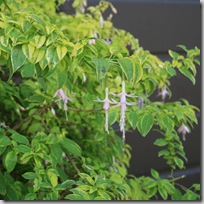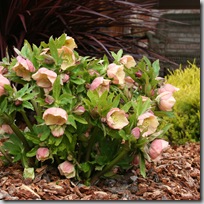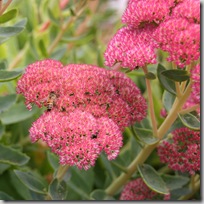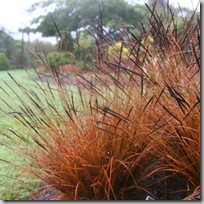When the Garden Designers Roundtable chose Top Landscape Plants as this month’s topic, I thought to myself, “Hey, no problem, I can write that in my sleep.” I mean, enthusing about plants is kind of my thing, you know?
But given that this is book excerpt week here at North Coast Gardening, I thought it’d be fun to hand over the stage to five favorite writers, and let them enthuse for me. While each writer comes to plants from a different perspective, they share a love of gardening and language that makes each a pleasure to read.
Without further ado, here are five of my top landscape plants:
Borage (Borago officianalis)
 From The Edible Front Yard by Ivette Soler:
From The Edible Front Yard by Ivette Soler:
“If, while strolling through a garden, you see little blue shooting stars exploding over a fountain of fuzzy leaves, you have stumbled upon borage. The luminous clusters of pinky-purple buds start off pendulous, then rear up and make themselves known with a burst of color. The edible grayish-green fuzzy leaves and stems of borage are a wonderful foil for darker foliage in the garden.”
While borage is a rampant self-sower in my climate, the cheerful blue blossoms attract honeybees and a number of other pollinators. This makes it a joy to photograph, since there’s always a bumbling somebody ambling along, ready for their close-up.
Fuchsia (Fuchsia magellanica)
 From The Food-Lover’s Garden by Mark Diacono:
From The Food-Lover’s Garden by Mark Diacono:
“I have never been a great fan of fuchsias to look at. They remind me of the gardens of the retirement homes I walked past on my way to school, and I loathe their gaudy red/purple flowers. It took me a long time to allow the possibility of growing one, it really did, but I kept finding the odd reference to them being delicious if you could lay your hands on the right varieties. So buy one I did.
. . . their flavor is so very special, with suggestions of kiwifruit, plum, and sweet grapes, as well as a gentle edge of pepper that comes along near the end.”
While I don’t share Mark’s abhorrence of the fuchsia flower (I’d call them deliciously flamboyant, not gaudy!), I do share his adoration of fuchsia berries. In an organic garden, you can feel safe eating the berries of Fuchsia magellanica, a 6′ x 6′ shade-loving shrub that comes with either the traditional magenta and purple flower or a gentle lilac-colored flower, with foliage in green, gold- or cream-variegated. Mark has a recipe for fuchsia fruit roll-up that’s perfect for people like me, who have grown up in body but not necessarily in spirit.
Hellebore (Helleborus orientalis)
 From Wicked Plants by Amy Stewart:
From Wicked Plants by Amy Stewart:
“Low-growing perennials produce dramatic, dark green foliage and beautiful five-petaled blossoms in shades of pale green, white, pink, red, and maroon that appear in winter and early spring. All parts of the plant are poisonous. The sap is irritating to the skin, and symptoms of ingestion include burning of the mouth, vomiting, dizziness, nervous system depression, and convulsions.
The First Sacred War (595-585 BC) is believed by some historians to have been won after a Greek military alliance poisoned the water supply of the city of Kirrha with hellebore. This would have been one of the first instances of chemical warfare in history.”
Well, if all that hasn’t put you off of hellebore as a garden plant, may I point out that it is also low-maintenance, deer-resistant, tolerant of shady locations, and blooms at a time of year when little else is going on? And that the leathery leaves are of such a texture that nobody in their right mind would chew on them? And that breeders have come up with new varieties in shades of apricot, yellow-with-speckles, and metallic blue-black, among others? Really. It’s a very nice plant.
Hardy Stonecrop (Sedum ‘Autumn Joy’)
 From Mrs. Greenthumbs by Cassandra Danz:
From Mrs. Greenthumbs by Cassandra Danz:
“Sedum, that bastion of the dry sun-drenched garden, is also very accommodating in dry shade. Sedum ‘Autumn Joy’, with its grayish fleshy leaves and deep red flowers, has a lot of style, and no garden should be without it. Trouble is, this sedum is so popular, practically no garden is without it! But even though they may not be exotic, drifts of sedum are a welcome sight in September.”
Thank you Cassandra, for pointing out that just because a plant is common, is no reason to shun it. Heaven forefend you should end up with a plant that grows lusciously, has a long season of bloom, and is nearly trouble-free. Which, let’s face it, when a place has all of those fine qualities, it generally becomes popular in short order.
Let’s get rid of garden snobbery and just commit to doing new and interesting things with some of these tried-and-true favorites.
Hook Sedge (Uncinia uncinata)
 From Fearless Color Gardens by Keeyla Meadows:
From Fearless Color Gardens by Keeyla Meadows:
“Orange offers that special adventure of versatility. Orange can be very modern. Orange can be that comic book blast of “pow!” It can be a sublime chorus of the devoted, standing at the shore at sunset, receiving the day’s last rays. Orange is an orangutan of a color, swinging from the pot of gold at the end of the rainbow to the edgy explorations of the artistically inclined.”
Whenever I’m bored with thinking about or writing about plants, I pick up Keeyla Meadow’s book on color and just let her words wash over me. She IS fearless, and her bold take on color is generally just what I need to shake off any garden doldrums and get that new-gardener’s sense of awe and excitement back.
On to Uncinia: this easy grower is the ultimate Halloween plant. Orange all year, with black blooms in September that hang on through Halloween and make a fun foil to any black flowers you care to cultivate nearby. It has a simple dignity most of the year, but is unafraid of the spotlight; I think Keeyla would approve.
Where do you find plant inspiration? Let me know in the comments below!
And be sure to check out my fellow designers’ posts in this month’s Garden Designers Roundtable:
Nan Ondra : Hayefield : Bucks County, PA
Andrew Keys : Garden Smackdown : Boston, MA
Christina Salwitz : Personal Garden Coach : Renton, WA
Genevieve Schmidt : North Coast Gardening : Arcata, CA
Ivette Soler : The Germinatrix : Los Angeles, CA
Jocelyn Chilvers : The Art Garden : Denver, CO
Laura Livengood Schaub : Interleafings : San Jose, CA
Lesley Hegarty & Robert Webber : Hegarty Webber Partnership : Bristol, UK
Rebecca Sweet : Gossip In the Garden : Los Altos, CA
Rochelle Greayer : Studio G : Boston, MA
Susan Morrison : Blue Planet Garden Blog : East Bay, CA
[print_link]
30 responses to “Top Landscape Plants (Excerpts from Experts)”
I find plant inspiration in so many places with the vast amount of information and photos available on the internet. Sites like yours and others are always a joy to read and either learn about new plants or be reminded of ones I’ve planted in the past. Of course I am possibly just a little short-sighted these days since I rarely plant anything other than dwarf conifers. Once in a while I do become inspired by a pretty flower or a new Hosta. BTW, one of my favorites is the first one on your list. I love bees and bees love Borage, so I do like to keep that in the garden as well as other culinary and healthful herbs.
Ed, isn’t it lovely how bees bring movement to the garden? And I think the blue flowers would go so well with the hues of almost any dwarf conifer.
I tried borage because it was advertised as edible. Can’t handle the hairy leaves, but I also read the plants don’t mind wet feet. So I moved them from the vegetable garden to the rain garden, and they are a delight. They are sweet to look at, self-sow and are easy to pull up. What more could you ask for?
Jackie, I never would have guessed they don’t mind wet feet! Thanks for the heads-up on that. Awesome!
Great reminder about borage–I have a packet of seeds sitting around just waiting to be used, and have been meaning to get to it for ages now. Also sedum “autumn joy,” which is lovely in masses and which I need to get into the perennial border or possibly onto the rain garden’s berm.
Oh, aren’t they lovely massed? I love watching the birds cling to their spent flowerheads to eat the seeds in winter.
I spend way too much time looking at plant photos on websites for local nurseries. My favorites are Xera, Cistus, Joy Creek, Dancing Oaks and Far Reaches. Also, plantlust.com is a great plant finder that includes those nurseries plus others, including Plant Delights. I’ve taken to using tumblr to store photos of “wishlist” plants. I have one tumblr for planting scheme ideas (and other garden design ideas) and another just for single plants I want. I like it because I can record where I got the picture from. I also turn to blogs for ornamental gardening in my area, Portland Oregon, because if they can grow it, I can grow it. For drool-worthy fantasy plants I turn to A Growing Obsession.
Why, oh why, did I take your advice to go check out A Growing Obsession? I am now enviously plotting out my next nursery order… I adore Xera, but wish they had more photos! Their descriptions are lovely.
Nice! I’m taking a similar “advice from other experts” approach on my GDRT post next week as well. I think I need to check out Keeyla Meadows’ book as I’m a color nut myself. Any chance you’re giving THAT one away any time soon?
LOL, you never know, Susan!!! Can’t wait to read your GDRT post!
[…] Genevieve Schmidt : North Coast Gardening : Arcata, CA […]
[…] Genevieve Schmidt : North Coast Gardening : Arcata, CA […]
What a fun way to present your favorites, Genevieve. That hook sedge is absolutely gorgeous. And gee, I feel kind of dumb that I never knew that fuchsias made edible berries!
Nan, that whole book, The Food Lover’s Garden, will make you feel that way. Like, OH! I had no idea I could eat YOU!! My garden plants are quaking in their boots.
[…] Genevieve Schmidt : North Coast Gardening : Arcata, CA […]
[…] Genevieve Schmidt : North Coast Gardening : Arcata, CA […]
[…] Genevieve Schmidt : North Coast Gardening : Arcata, CA […]
Great post, Gen! I love your choices, both of plants and of authors (and just think, we KNOW some of those cool people!) Now I totally want to try a Fuchsia berry. And who knew that Uncinia blooms like that? I smiled at your borage picture (with the “bumbling somebody ambling along”) my daughter’s first birthday cake many years ago was chocolate with sugared borage flowers sprinkled all over it. Epic.
YUM, Interleafie! I’ll have to try that one of these days.
Yeah, I’m in awe that we actually know so many of these talented people. It’s crazy!
[…] Genevieve Schmidt : North Coast Gardening : Arcata, CA […]
Loved your excellent point about not rejecting the tried, tested and downright common. After all it is what you do with the plants, how you mass them and use their textures rather than the plants themselves which creates the whole ‘knitted together’ garden.
Thanks for an insightful post!
Best
R
Robert, as always, an insightful contribution. YES! Couldn’t agree more.
Fun take on the topic, Gen! Many thanks for your comment about dropping the plant snobbery, already! Let’s build beautiful gardens with ALL kinds of plants, not just the flavor-of-the-month varieties.
A Halloween plant–I love that Uncinia uncinata! I have never seen it here in Austin and wonder if it would tolerate our extreme conditions. Off to research.
Ah, nope. “Cool, moist conditions,” I read on Annie’s Annuals. Figures. I’ll just have to admire that one from afar. I’m still glad to know about it.
I was just going to say – if you have a stream nearby??? It rains here so much that we get a lot of moisture-loving plants thriving here.
Love your creative approach to this month’s topic, Gen! You’ve picked great excerpts which give us a flavor of these authors’ voices! Plus, I had no idea there were fuchsia recipes out there!! I remember, as a kid, gently pulling out the center of the fuchsia flower to get the long, skinny thread that was seemingly ‘dipped in honey’….but always felt so bad about destroying a flower that I couldn’t bear to keep doing this!
LOVE this post for SO many reasons! Thanks for the shout -out on my adoration of borage! It self seeds like crazy here, too – but how could I deny the bees one of their favorites? And I’ve been taking the baby volunteers and adding the leaves to stir-frys – YUM!
I love the point on Sedum ‘Autumn Joy’ – just because it’s common doesn’t mean we should turn up our noses! Boo to hort snobbery, right? A good plant is a good plant!
And you TOTALLY got me when you said the Uncinia is the ultimate Halloween plant! You know that means I am going to plant tons of it in my front yard now – how could I resist a grass that will make my favorite holiday even SPOOKIER?
A delightful post, as usual, Gen! And tying it in to Book Week – a coup!
XOXO!!!
As a book lover I really appreciate your post. I don’t have two of those books, but have now ordered them. Sometimes it’s as hard to find places for new books on my shelves as it is to find space for new plants in my garden…off to find some of these too!
I had no idea fuchsia berries were edible! My sister and I used to squish them between our fingers to stain them purple (the things kids do). Plant inspiration? Local is always best–this way I know what grows here…